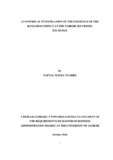| dc.description.abstract | The objective of this study was to find out if the Ramadhan Effect exists in the Nairobi
Securities Exchange. Ramadan is the ninth month of the Islamic lunar calendar, a
calendar that contains twelve months each starting with the sighting of a new moon. The
Islamic lunar year is approximately 11 days shorter than the Gregorian solar year. So,
over time, Ramadan does not coincide systematically the Gregorian calendar. During the
month of Ramadhan Muslims dedicate themselves to prayers and fasting from dawn to
dusk. The lifestyle changes during the month of Ramadhan would make one to suspect
that there is a resultant economic impact. The study covered a period of 13 years,
between 1st Jan 2001 and Dec 31 2013. We initially sought to do a 15 year period but
this was narrowed down to a 13 year period due to the non-availability of data for the
years 1999 and 2000. To determine whether there is a Ramadhan effect, we measured the
monthly returns for the calendar months in the period 2001-2013. The mean returns of
the Non Ramadhan months were compared with that of the month of Ramadhan. A
statistical test was used to determine the significance of the difference of the two sets of
returns so as to conclude about the presence or absence of the Ramadhan Effect. The
monthly returns were calculated using the market index movements between the
beginning and end of calendar months. The months of January was excluded because of
the possibility of the January effect affecting the outcome of the findings and since the
Ramadhan months don’t always coincide with the usual calendar month, for consistence
and simplicity in calculation, the calendar months where Ramadhan begins and ends in
the middle were excluded from the analysis. This left us with nine calendar monthly
returns to compare with the Ramadhan Month. However, in the years 2008 and 2011 the
Ramadhan month and calendar months start and end dates coincided so in these two years
we have 10 non-Ramadhan months to compare with the Ramadhan month. Monthly
returns were examined using the regression methodology developed by Connolly (1989)
and used by Kimonda (2006). The regression model was used to regress annual returns
against monthly returns. A t test is used to test the statistical significance of the difference
of the two means so as to conclude about the presence or absence of the Ramadhan
Effect. Results of the analysis showed that returns during the months of Ramadhan
tended to be lower than those of the other months. A statistical test of significance
however revealed that the difference in the returns was not significant. A repeat of the
examination using event study approach yielded similar results. | en_US |

